air condition TOYOTA YARIS HYBRID 2016 Owners Manual
[x] Cancel search | Manufacturer: TOYOTA, Model Year: 2016, Model line: YARIS HYBRID, Model: TOYOTA YARIS HYBRID 2016Pages: 492, PDF Size: 31.95 MB
Page 4 of 492
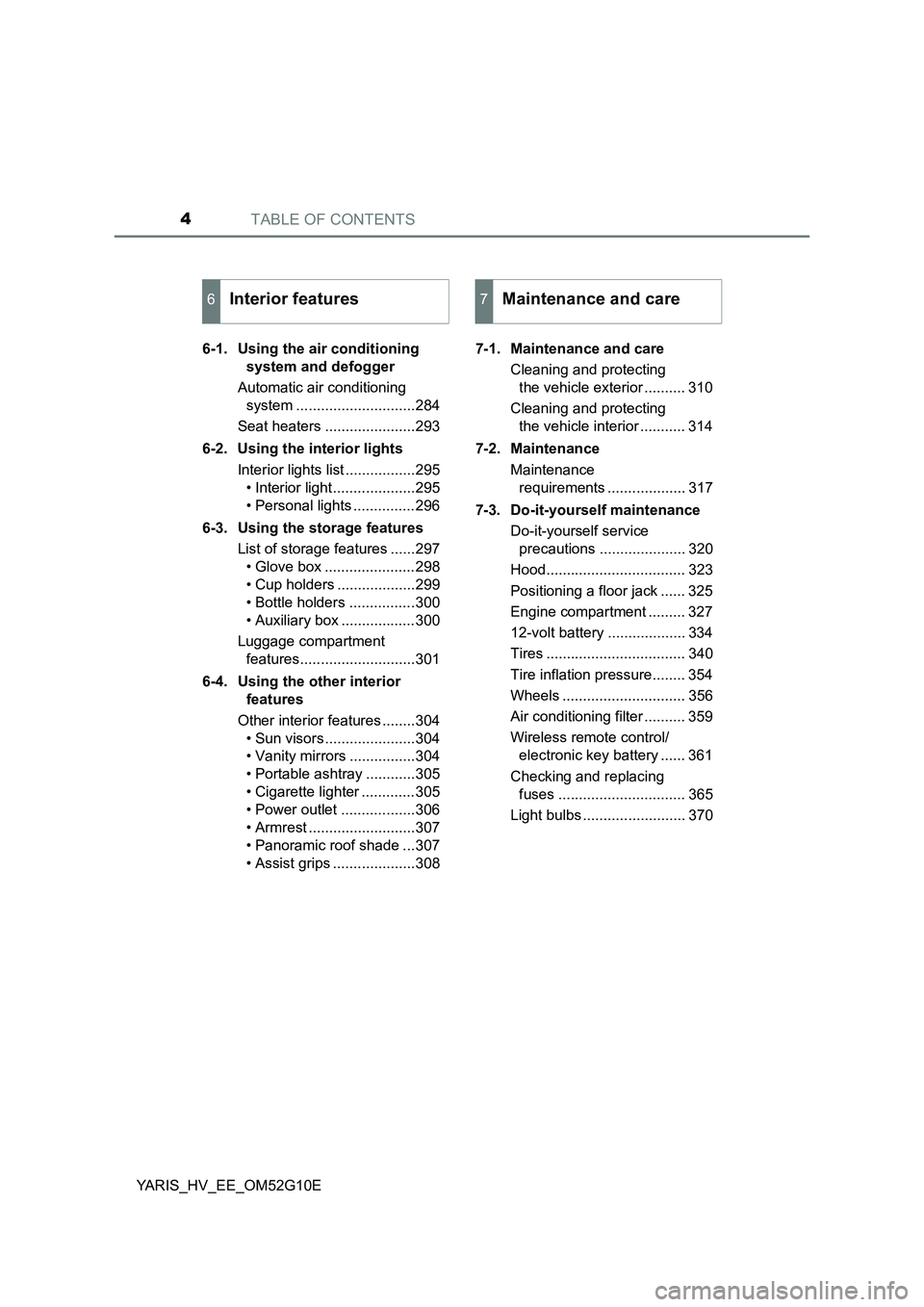
TABLE OF CONTENTS4
YARIS_HV_EE_OM52G10E
6-1. Using the air conditioning
system and defogger
Automatic air conditioning
system .............................284
Seat heaters ......................293
6-2. Using the interior lights
Interior lights list .................295
• Interior light ....................295
• Personal lights ...............296
6-3. Using the storage features
List of storage features ......297
• Glove box ......................298
• Cup holders ...................299
• Bottle holders ................300
• Auxiliary box ..................300
Luggage compartment
features............................301
6-4. Using the other interior
features
Other interior features ........304
• Sun visors ......................304
• Vanity mirrors ................304
• Portable ashtray ............305
• Cigarette lighter .............305
• Power outlet ..................306
• Armrest ..........................307
• Panoramic roof shade ...307
• Assist grips ....................308
7-1. Maintenance and care
Cleaning and protecting
the vehicle exterior .......... 310
Cleaning and protecting
the vehicle interior ........... 314
7-2. Maintenance
Maintenance
requirements ................... 317
7-3. Do-it-yourself maintenance
Do-it-yourself service
precautions ..................... 320
Hood.................................. 323
Positioning a floor jack ...... 325
Engine compartment ......... 327
12-volt battery ................... 334
Tires .................................. 340
Tire inflation pressure........ 354
Wheels .............................. 356
Air conditioning filter .......... 359
Wireless remote control/
electronic key battery ...... 361
Checking and replacing
fuses ............................... 365
Light bulbs ......................... 370
6Interior features7Maintenance and care
Page 15 of 492

15Pictorial index
YARIS_HV_EE_OM52G10E
Multi-information display . . . . . . . . . . . . . . . . . . . . . . . . . . . P. 100
Parking brake . . . . . . . . . . . . . . . . . . . . . . . . . . . . . . . . . . . . . P. 194
Applying/releasing . . . . . . . . . . . . . . . . . . . . . . . . . . . . . . . . . . P. 194
Precautions against winter season . . . . . . . . . . . . . . . . . . . . . P. 247
Warning buzzer . . . . . . . . . . . . . . . . . . . . . . . . . . . . . . . . . . . . P. 396
Turn signal lever . . . . . . . . . . . . . . . . . . . . . . . . . . . . . . . . . . P. 193
Headlight switch . . . . . . . . . . . . . . . . . . . . . . . . . . . . . . . . . . P. 195
Headlights/front position lights/tail lights . . . . . . . . . . . . . . . . . P. 195
Front fog lights*2/rear fog light . . . . . . . . . . . . . . . . . . . . . . . . P. 200
Wiper and washer switch . . . . . . . . . . . . . . . . . . . . . . . P. 202, 206
Usage (front) . . . . . . . . . . . . . . . . . . . . . . . . . . . . . . . . . . . . . . P. 202
Usage (rear) . . . . . . . . . . . . . . . . . . . . . . . . . . . . . . . . . . . . . . P. 206
Adding washer fluid . . . . . . . . . . . . . . . . . . . . . . . . . . . . . . . . . P. 333
Emergency flasher switch . . . . . . . . . . . . . . . . . . . . . . . . . . P. 386
Hood lock release lever . . . . . . . . . . . . . . . . . . . . . . . . . . . . P. 323
Tilt and telescopic steering lock release lever . . . . . . . . . . P. 155
Air conditioning system . . . . . . . . . . . . . . . . . . . . . . . . . . . . P. 284
Usage . . . . . . . . . . . . . . . . . . . . . . . . . . . . . . . . . . . . . . . . . . . P. 284
Rear window defogger. . . . . . . . . . . . . . . . . . . . . . . . . . . . . . . P. 288
Audio system*2. . . . . . . . . . . . . . . . . . . . . . . . . . . . . . . . . . . P. 250
Navigation/Multimedia system*2, 3
*1: Vehicles with a smart entry & start system
*2: If equipped
*3: Refer to “Navigation and multimedia system Owner’s manual”.
4
5
6
7
8
9
10
11
12
Page 22 of 492
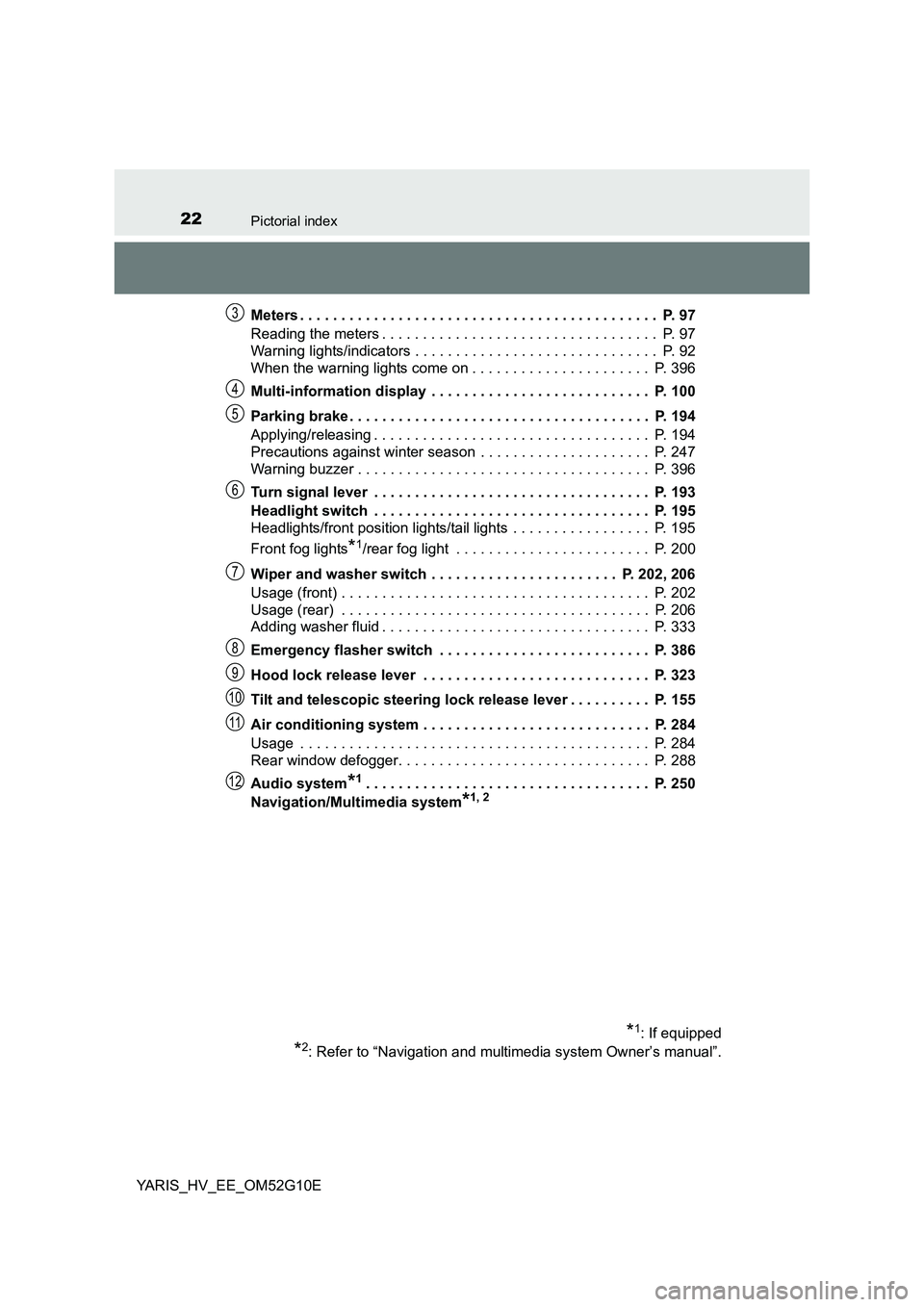
22Pictorial index
YARIS_HV_EE_OM52G10E
Meters . . . . . . . . . . . . . . . . . . . . . . . . . . . . . . . . . . . . . . . . . . . . P. 97
Reading the meters . . . . . . . . . . . . . . . . . . . . . . . . . . . . . . . . . . P. 97
Warning lights/indicators . . . . . . . . . . . . . . . . . . . . . . . . . . . . . . P. 92
When the warning lights come on . . . . . . . . . . . . . . . . . . . . . . P. 396
Multi-information display . . . . . . . . . . . . . . . . . . . . . . . . . . . P. 100
Parking brake . . . . . . . . . . . . . . . . . . . . . . . . . . . . . . . . . . . . . P. 194
Applying/releasing . . . . . . . . . . . . . . . . . . . . . . . . . . . . . . . . . . P. 194
Precautions against winter season . . . . . . . . . . . . . . . . . . . . . P. 247
Warning buzzer . . . . . . . . . . . . . . . . . . . . . . . . . . . . . . . . . . . . P. 396
Turn signal lever . . . . . . . . . . . . . . . . . . . . . . . . . . . . . . . . . . P. 193
Headlight switch . . . . . . . . . . . . . . . . . . . . . . . . . . . . . . . . . . P. 195
Headlights/front position lights/tail lights . . . . . . . . . . . . . . . . . P. 195
Front fog lights*1/rear fog light . . . . . . . . . . . . . . . . . . . . . . . . P. 200
Wiper and washer switch . . . . . . . . . . . . . . . . . . . . . . . P. 202, 206
Usage (front) . . . . . . . . . . . . . . . . . . . . . . . . . . . . . . . . . . . . . . P. 202
Usage (rear) . . . . . . . . . . . . . . . . . . . . . . . . . . . . . . . . . . . . . . P. 206
Adding washer fluid . . . . . . . . . . . . . . . . . . . . . . . . . . . . . . . . . P. 333
Emergency flasher switch . . . . . . . . . . . . . . . . . . . . . . . . . . P. 386
Hood lock release lever . . . . . . . . . . . . . . . . . . . . . . . . . . . . P. 323
Tilt and telescopic steering lock release lever . . . . . . . . . . P. 155
Air conditioning system . . . . . . . . . . . . . . . . . . . . . . . . . . . . P. 284
Usage . . . . . . . . . . . . . . . . . . . . . . . . . . . . . . . . . . . . . . . . . . . P. 284
Rear window defogger. . . . . . . . . . . . . . . . . . . . . . . . . . . . . . . P. 288
Audio system*1. . . . . . . . . . . . . . . . . . . . . . . . . . . . . . . . . . . P. 250
Navigation/Multimedia system*1, 2
*1: If equipped
*2: Refer to “Navigation and multimedia system Owner’s manual”.
3
4
5
6
7
8
9
10
11
12
Page 48 of 492
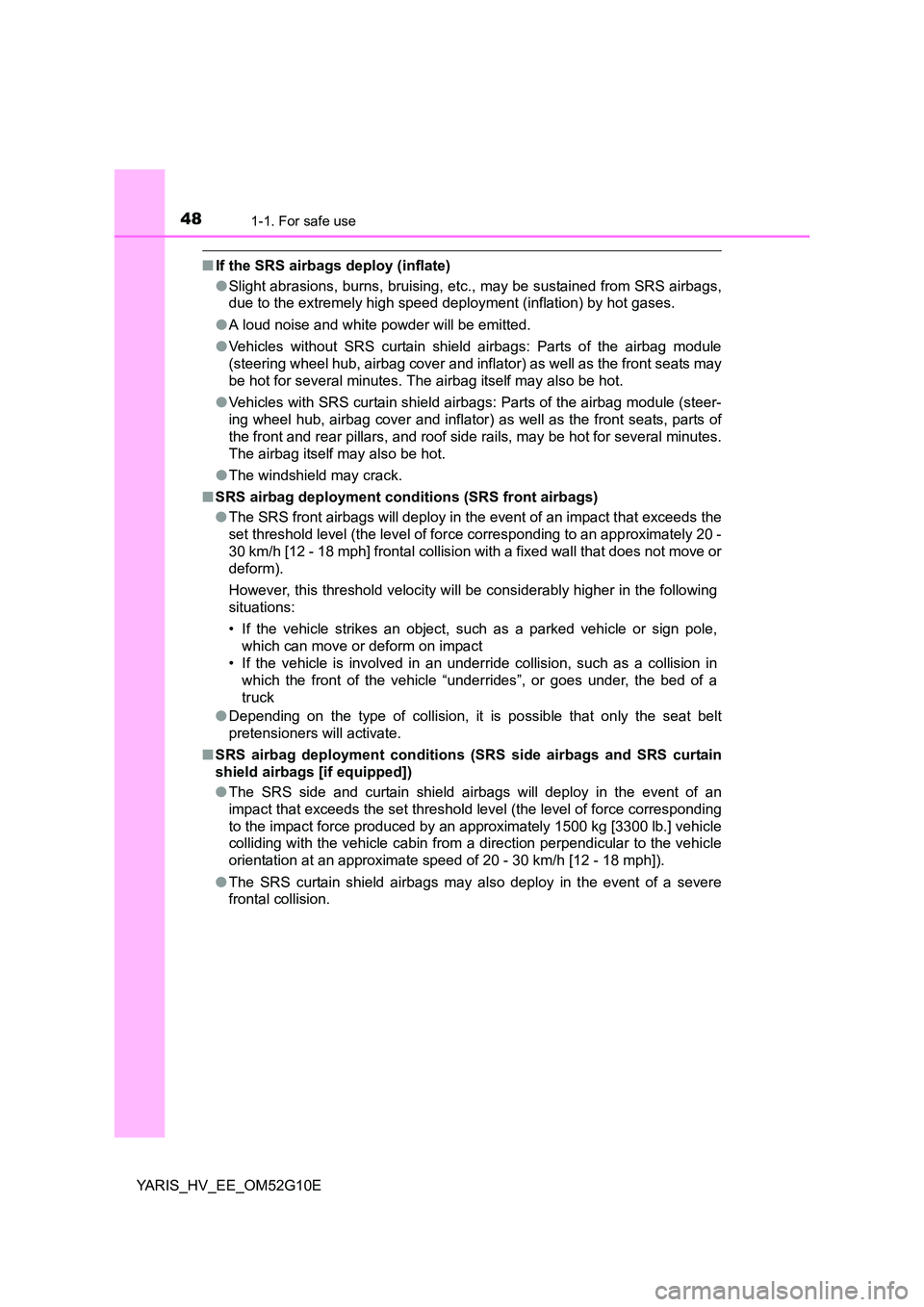
481-1. For safe use
YARIS_HV_EE_OM52G10E
■If the SRS airbags deploy (inflate)
● Slight abrasions, burns, bruising, etc., may be sustained from SRS airbags,
due to the extremely high speed deployment (inflation) by hot gases.
● A loud noise and white powder will be emitted.
● Vehicles without SRS curtain shield airbags: Parts of the airbag module
(steering wheel hub, airbag cover and inflator) as well as the front seats may
be hot for several minutes. The airbag itself may also be hot.
● Vehicles with SRS curtain shield airbags: Parts of the airbag module (steer-
ing wheel hub, airbag cover and inflator) as well as the front seats, parts of
the front and rear pillars, and roof side rails, may be hot for several minutes.
The airbag itself may also be hot.
● The windshield may crack.
■ SRS airbag deployment conditions (SRS front airbags)
● The SRS front airbags will deploy in the event of an impact that exceeds the
set threshold level (the level of force corresponding to an approximately 20 -
30 km/h [12 - 18 mph] frontal collision with a fixed wall that does not move or
deform).
However, this threshold velocity will be considerably higher in the following
situations:
• If the vehicle strikes an object, such as a parked vehicle or sign pole,
which can move or deform on impact
• If the vehicle is involved in an underride collision, such as a collision in
which the front of the vehicle “underrides”, or goes under, the bed of a
truck
● Depending on the type of collision, it is possible that only the seat belt
pretensioners will activate.
■ SRS airbag deployment conditions (SRS side airbags and SRS curtain
shield airbags [if equipped])
● The SRS side and curtain shield airbags will deploy in the event of an
impact that exceeds the set threshold level (the level of force corresponding
to the impact force produced by an approximately 1500 kg [3300 lb.] vehicle
colliding with the vehicle cabin from a direction perpendicular to the vehicle
orientation at an approximate speed of 20 - 30 km/h [12 - 18 mph]).
● The SRS curtain shield airbags may also deploy in the event of a severe
frontal collision.
Page 49 of 492
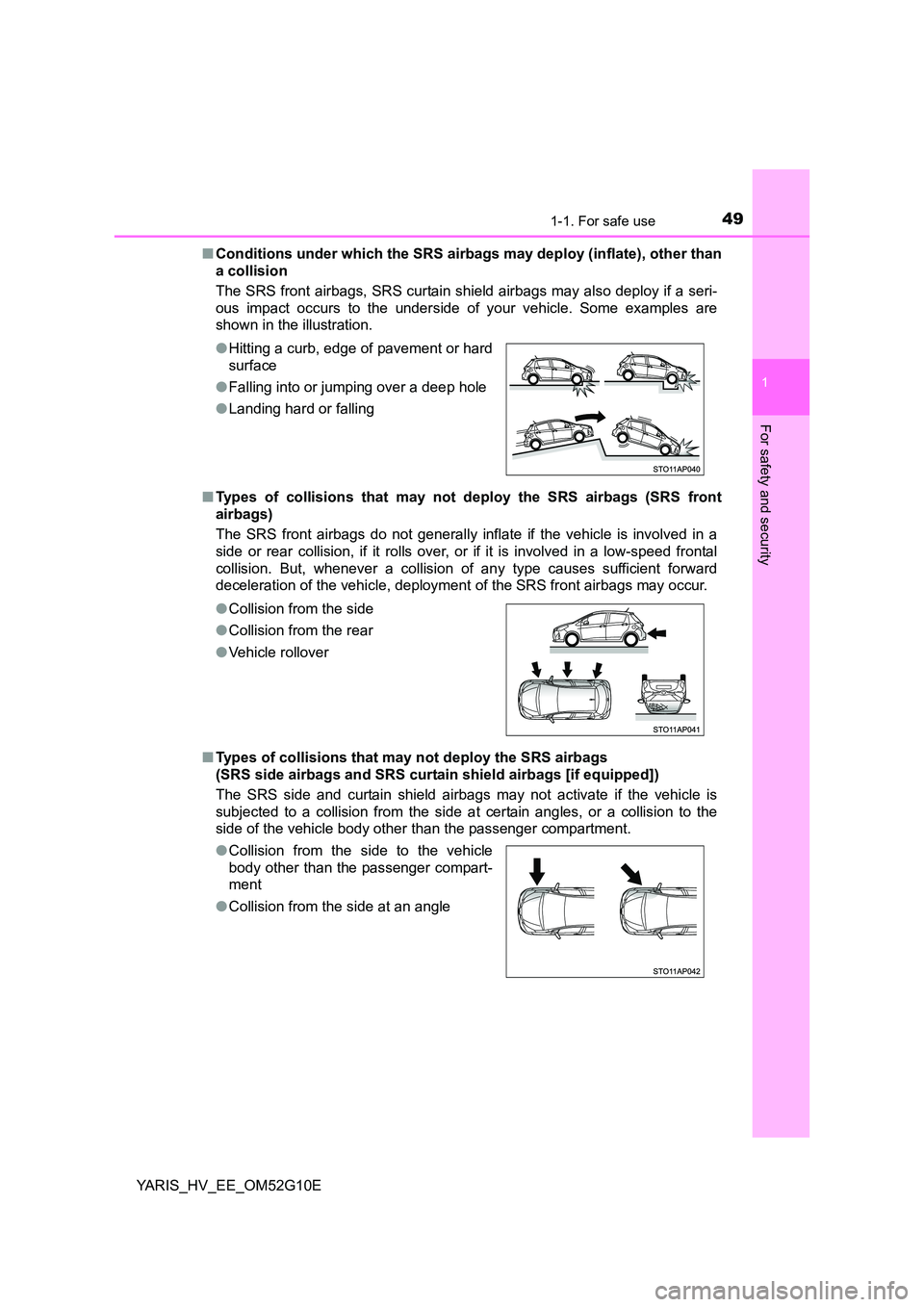
491-1. For safe use
1
For safety and security
YARIS_HV_EE_OM52G10E
■ Conditions under which the SRS airbags may deploy (inflate), other than
a collision
The SRS front airbags, SRS curtain shield airbags may also deploy if a seri-
ous impact occurs to the underside of your vehicle. Some examples are
shown in the illustration.
■ Types of collisions that may not deploy the SRS airbags (SRS front
airbags)
The SRS front airbags do not generally infl ate if the vehicle is involved in a
side or rear collision, if it rolls over, or if it is involved in a low-speed frontal
collision. But, whenever a collision of any type causes sufficient forward
deceleration of the vehicle, deployment of the SRS front airbags may occur.
■ Types of collisions that may not deploy the SRS airbags
(SRS side airbags and SRS curtain shield airbags [if equipped])
The SRS side and curtain shield airbags may not activate if the vehicle is
subjected to a collision from the side at certain angles, or a collision to the
side of the vehicle body other than the passenger compartment.
● Hitting a curb, edge of pavement or hard
surface
● Falling into or jumping over a deep hole
● Landing hard or falling
● Collision from the side
● Collision from the rear
● Vehicle rollover
●Collision from the side to the vehicle
body other than the passenger compart-
ment
● Collision from the side at an angle
Page 77 of 492
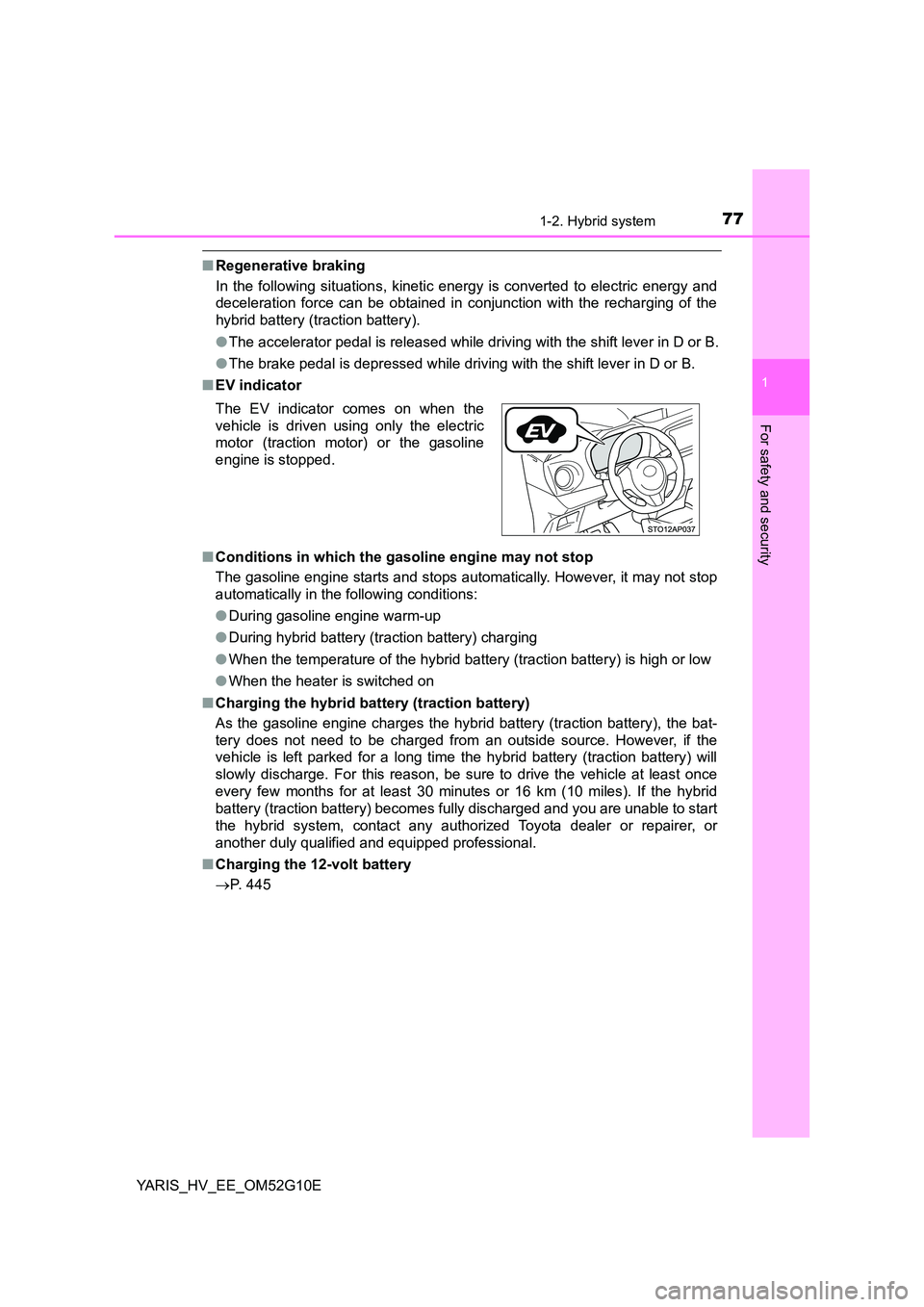
771-2. Hybrid system
1
For safety and security
YARIS_HV_EE_OM52G10E
■Regenerative braking
In the following situations, kinetic ener gy is converted to electric energy and
deceleration force can be obtained in conjunction with the recharging of the
hybrid battery (traction battery).
● The accelerator pedal is released while driving with the shift lever in D or B.
● The brake pedal is depressed while driving with the shift lever in D or B.
■ EV indicator
■ Conditions in which the gasoline engine may not stop
The gasoline engine starts and stops automatically. However, it may not stop
automatically in the following conditions:
● During gasoline engine warm-up
● During hybrid battery (traction battery) charging
● When the temperature of the hybrid battery (traction battery) is high or low
● When the heater is switched on
■ Charging the hybrid battery (traction battery)
As the gasoline engine charges the hybrid battery (traction battery), the bat-
tery does not need to be charged from an outside source. However, if the
vehicle is left parked for a long time t he hybrid battery (traction battery) will
slowly discharge. For this reason, be sure to drive the vehicle at least once
every few months for at least 30 minutes or 16 km (10 miles). If the hybrid
battery (traction battery) becomes fully discharged and you are unable to start
the hybrid system, contact any authorized Toyota dealer or repairer, or
another duly qualified and equipped professional.
■ Charging the 12-volt battery
P. 445
The EV indicator comes on when the
vehicle is driven using only the electric
motor (traction motor) or the gasoline
engine is stopped.
Page 79 of 492
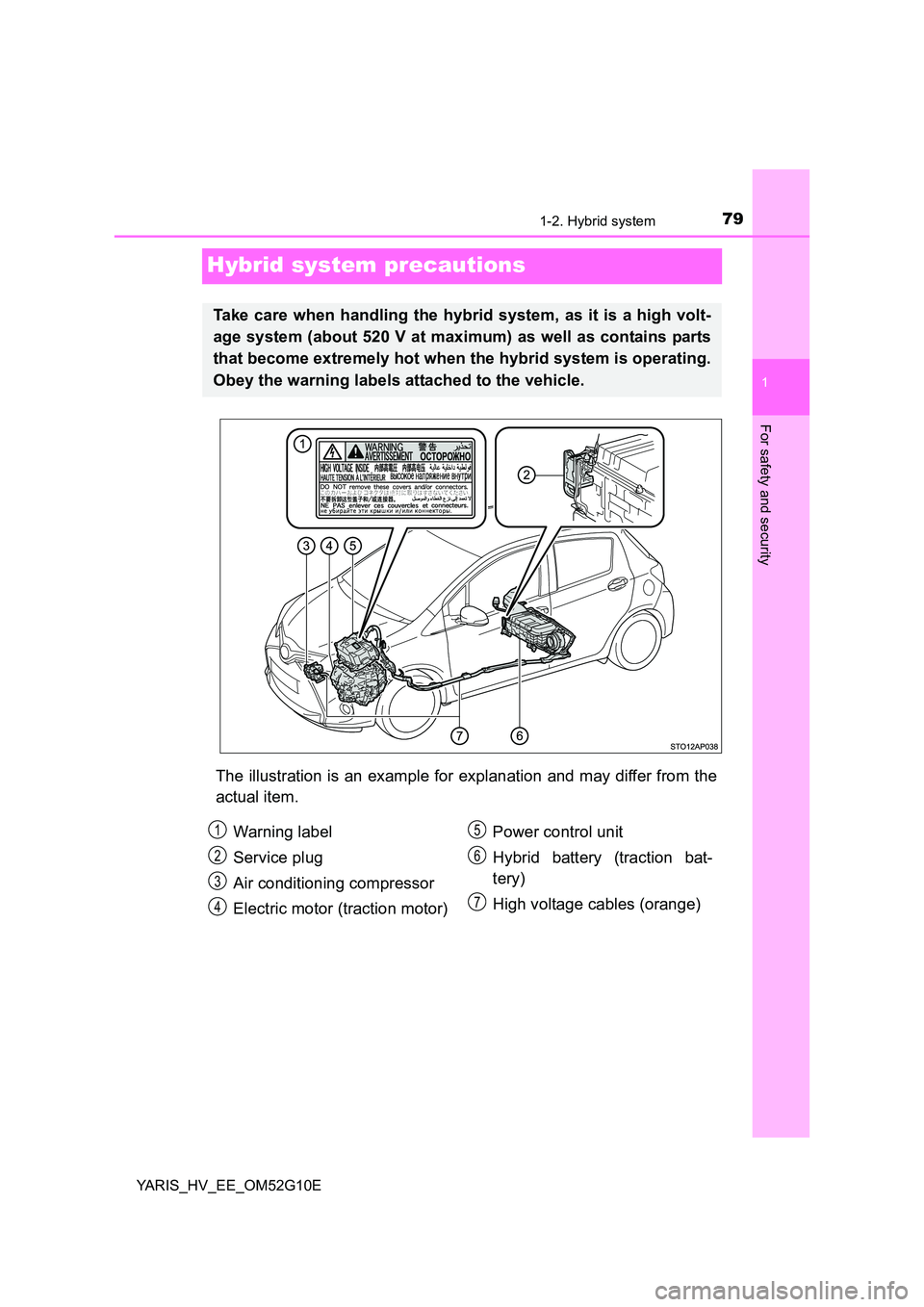
79
1
1-2. Hybrid system
For safety and security
YARIS_HV_EE_OM52G10E
Hybrid system precautions
The illustration is an example for explanation and may differ from the
actual item.
Take care when handling the hybrid system, as it is a high volt-
age system (about 520 V at maximum) as well as contains parts
that become extremely hot when the hybrid system is operating.
Obey the warning labels attached to the vehicle.
Warning label
Service plug
Air conditioning compressor
Electric motor (traction motor)
Power control unit
Hybrid battery (traction bat-
tery)
High voltage cables (orange)
1
2
3
4
5
6
7
Page 113 of 492
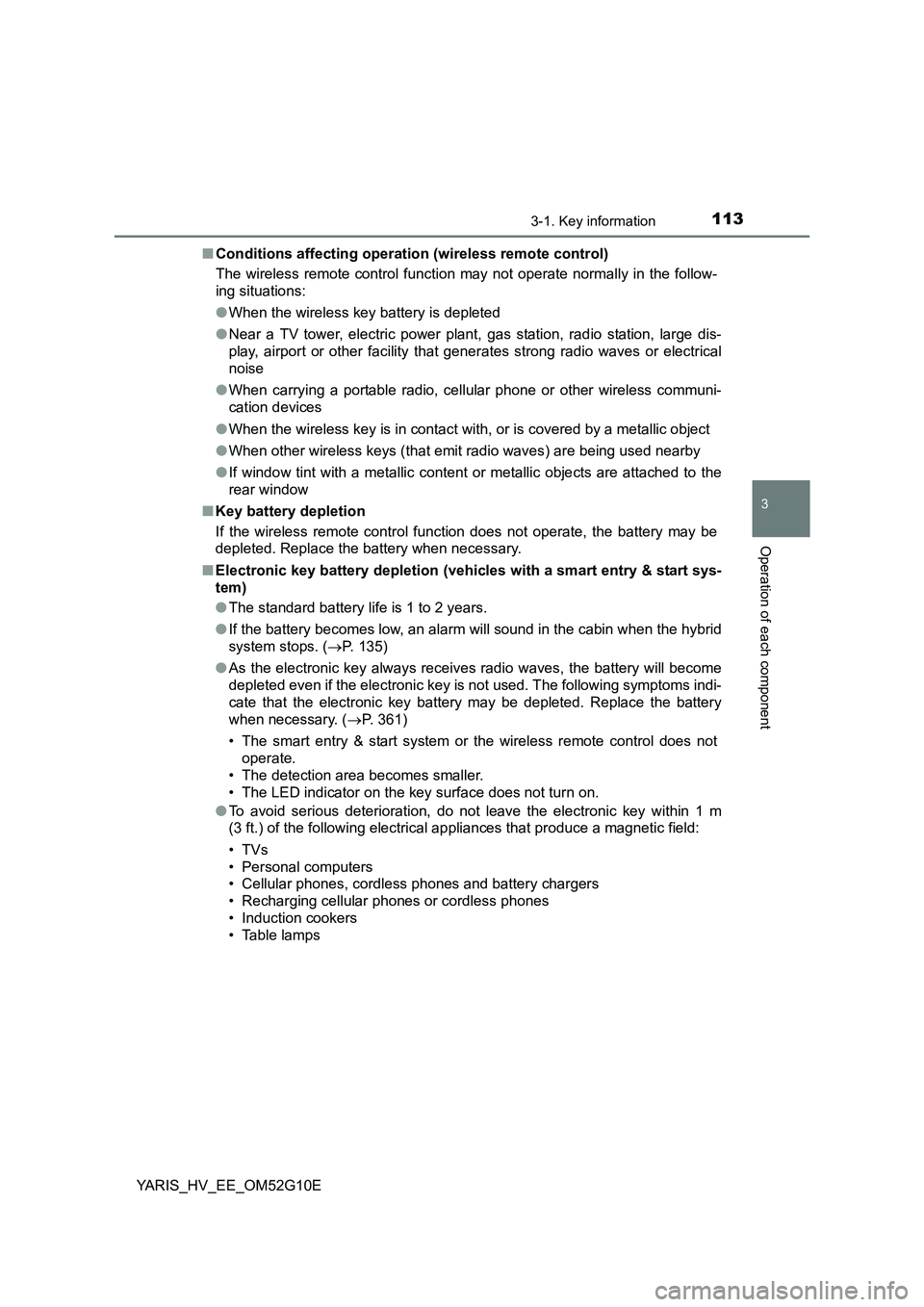
1133-1. Key information
3
Operation of each component
YARIS_HV_EE_OM52G10E
■ Conditions affecting operation (wireless remote control)
The wireless remote control function may not operate normally in the follow-
ing situations:
● When the wireless key battery is depleted
● Near a TV tower, electric power plant, gas station, radio station, large dis-
play, airport or other facility that generates strong radio waves or electrical
noise
● When carrying a portable radio, cellular phone or other wireless communi-
cation devices
● When the wireless key is in contact with, or is covered by a metallic object
● When other wireless keys (that emit radio waves) are being used nearby
● If window tint with a metallic content or metallic objects are attached to the
rear window
■ Key battery depletion
If the wireless remote control function does not operate, the battery may be
depleted. Replace the battery when necessary.
■ Electronic key battery depletion (vehicles with a smart entry & start sys-
tem)
● The standard battery life is 1 to 2 years.
● If the battery becomes low, an alarm will sound in the cabin when the hybrid
system stops. ( P. 135)
● As the electronic key always receives radio waves, the battery will become
depleted even if the electronic key is not used. The following symptoms indi-
cate that the electronic key battery may be depleted. Replace the battery
when necessary. ( P. 361)
• The smart entry & start system or the wireless remote control does not
operate.
• The detection area becomes smaller.
• The LED indicator on the key surface does not turn on.
● To avoid serious deterioration, do not leave the electronic key within 1 m
(3 ft.) of the following electrical appliances that produce a magnetic field:
•TVs
• Personal computers
• Cellular phones, cordless phones and battery chargers
• Recharging cellular phones or cordless phones
• Induction cookers
• Table lamps
Page 137 of 492
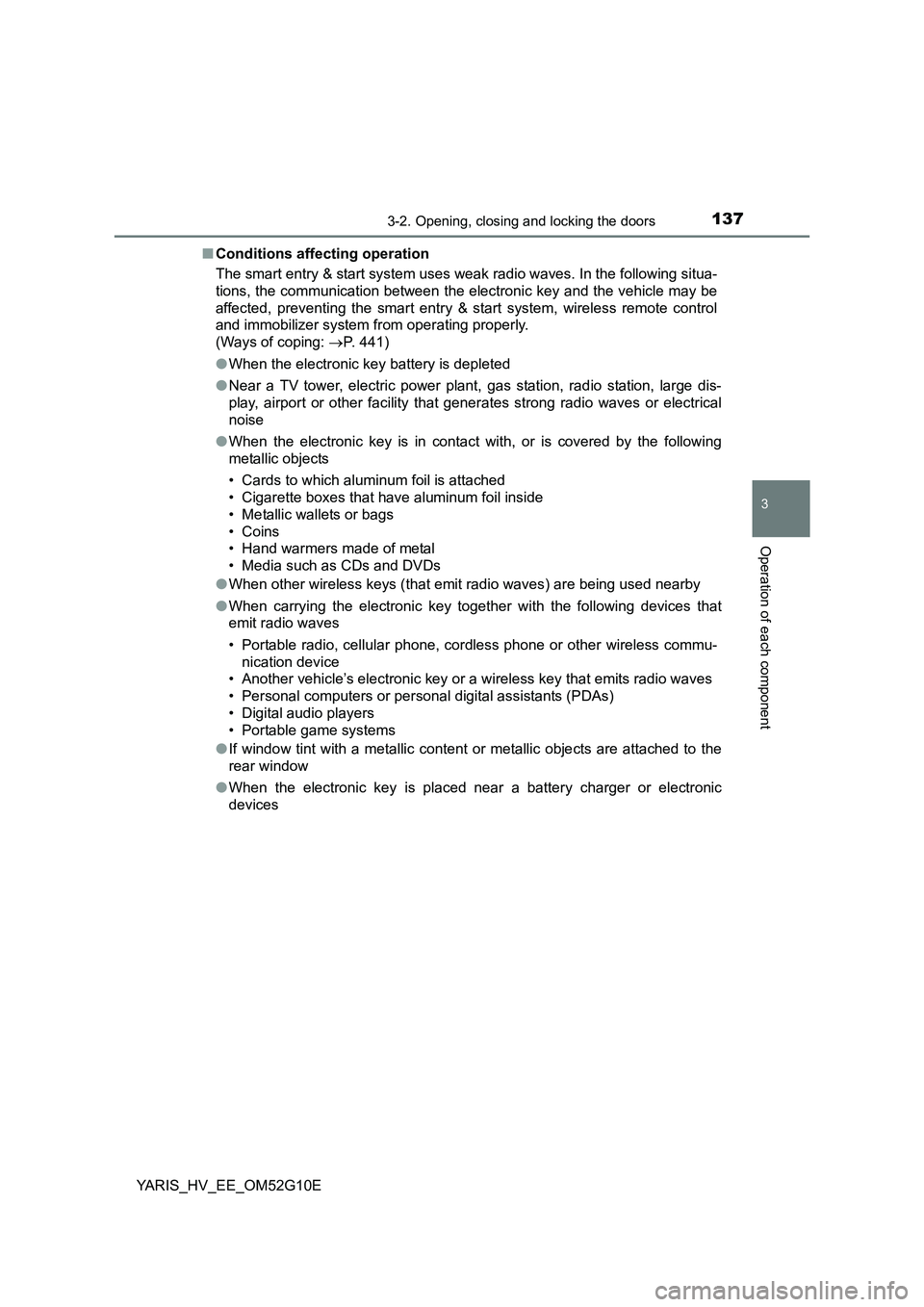
1373-2. Opening, closing and locking the doors
3
Operation of each component
YARIS_HV_EE_OM52G10E
■ Conditions affecting operation
The smart entry & start system uses weak radio waves. In the following situa-
tions, the communication between the electronic key and the vehicle may be
affected, preventing the smart entry & start system, wireless remote control
and immobilizer system from operating properly.
(Ways of coping: P. 441)
● When the electronic key battery is depleted
● Near a TV tower, electric power plant, gas station, radio station, large dis-
play, airport or other facility that generates strong radio waves or electrical
noise
● When the electronic key is in contact with, or is covered by the following
metallic objects
• Cards to which aluminum foil is attached
• Cigarette boxes that have aluminum foil inside
• Metallic wallets or bags
• Coins
• Hand warmers made of metal
• Media such as CDs and DVDs
● When other wireless keys (that emit radio waves) are being used nearby
● When carrying the electronic key together with the following devices that
emit radio waves
• Portable radio, cellular phone, cordless phone or other wireless commu-
nication device
• Another vehicle’s electronic key or a wireless key that emits radio waves
• Personal computers or personal digital assistants (PDAs)
• Digital audio players
• Portable game systems
● If window tint with a metallic content or metallic objects are attached to the
rear window
● When the electronic key is placed near a battery charger or electronic
devices
Page 175 of 492

1754-1. Before driving
4
Driving
YARIS_HV_EE_OM52G10E
NOTICE
■Avoiding damage to vehicle parts
● Do not turn the steering wheel fully in either direction and hold it there for
an extended period of time.
Doing so may damage the power steering motor.
● When driving over bumps in the road, drive as slowly as possible to avoid
damaging the wheels, underside of the vehicle, etc.
■ If you get a flat tire while driving
A flat or damaged tire may cause the following situations. Hold the steering
wheel firmly and gradually depress the brake pedal to slow down the vehi-
cle.
● It may be difficult to control your vehicle.
● The vehicle will make abnormal sounds or vibrations.
● The vehicle will lean abnormally.
Information on what to do in case of a flat tire
( P. 407, 422)
■ When encountering flooded roads
Do not drive on a road that has flooded after heavy rain etc. Doing so may
cause the following serious damage to the vehicle:
● Engine stalling
● Short in electrical components
● Engine damage caused by water immersion
In the event that you drive on a flooded road and the vehicle is flooded, be
sure to have any authorized Toyota deale r or repairer, or another duly quali-
fied and equipped professional check the following:
● Brake function
● Changes in quantity and quality of oil and fluid used for the engine, hybrid
transmission, etc.
● Lubricant condition for the bearings and suspension joints (where possi-
ble), and the function of all joints, bearings, etc.